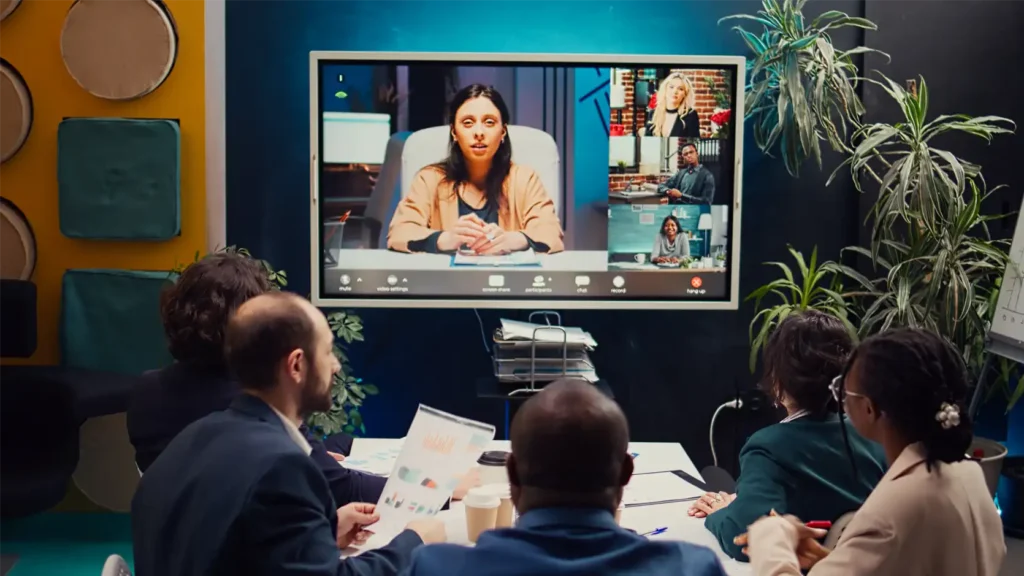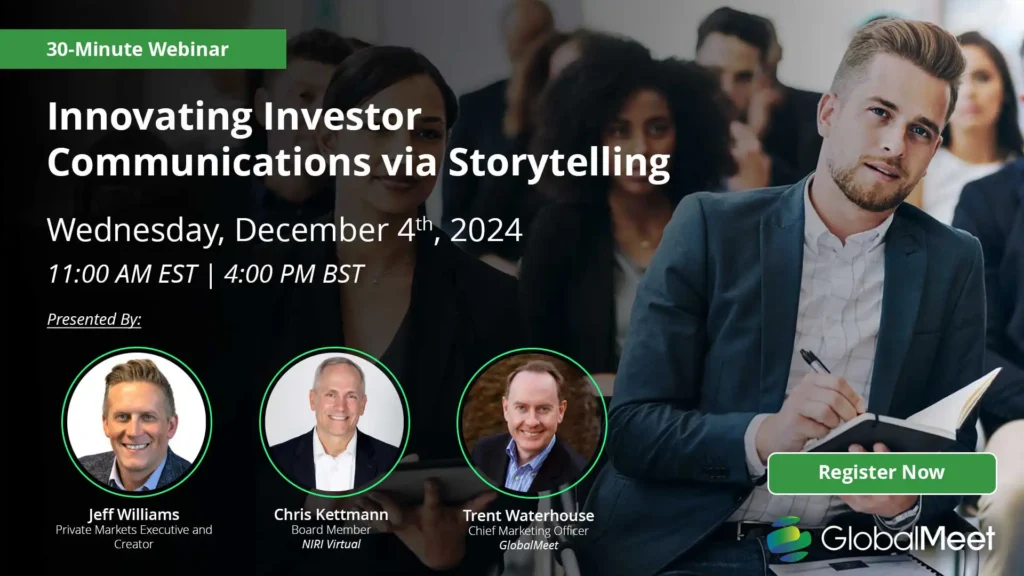
Mastering 2025: Elevate Your Event Strategy with Virtual and Hybrid Innovations
- by GlobalMeet Blog Team
- ,
As we approach 2025 the events industry is on the cusp of a dynamic transformation. With increasing emphasis on accessibility, sustainability, and inclusivity, event planners must embrace innovative formats to stay ahead. Virtual and hybrid event models are leading the charge, offering unparalleled opportunities to reach broader audiences while aligning with modern values. By adopting these strategies, you’ll not only meet the needs of today’s audiences but also future-proof your events. Let’s delve into actionable strategies to elevate your event planning by leveraging these formats effectively.
Broadening the Reach of Your Events
One of the most compelling advantages of virtual and hybrid events is their ability to make experiences more accessible to diverse audiences. By breaking down physical and geographical barriers, these formats enable participation for those who might otherwise be excluded.
Assistive Technologies: Implementing tools such as closed captioning, sign language interpretation, and screen reader compatibility ensures that your events cater to individuals with disabilities. Real-time translations can also bridge language barriers, opening your event to global audiences.
Customizable Participation: Virtual platforms can provide adaptable viewing and interaction options, accommodating various time zones, preferences, and needs. Offering downloadable materials, recorded sessions, and live Q&A opportunities further enriches the attendee experience. Tailor content for different demographics to make your event widely appealing.
By prioritizing accessibility, you’ll not only expand your audience but also foster inclusivity and goodwill. An accessible event is a clear statement that your brand values everyone’s participation.
Hosting Eco-Friendly Events
In an era of environmental consciousness, sustainability should be central to your event strategy. Virtual and hybrid formats inherently reduce the carbon footprint associated with traditional in-person gatherings. Consider these key practices:
Carbon Reduction Metrics: Eliminate the environmental impact of mass travel by enabling remote attendance. Promote public metrics showcasing reduced CO2 emissions from your virtual event to demonstrate your commitment to sustainability. Incorporate renewable energy sources in any physical venues used.
Paperless Solutions: Go fully digital with event brochures, schedules, and promotional materials to minimize waste. Platforms with integrated apps and QR codes can streamline these efforts and encourage attendees to embrace digital interactions.
Hybrid Event Optimization: For hybrid setups, incorporate local hubs or regional meetups to reduce extensive travel while maintaining in-person elements for engagement. Collaborate with eco-friendly vendors to source sustainable materials for physical components of the event.
Sustainable events are not only better for the planet but also appeal to environmentally-conscious audiences, enhancing your brand’s reputation with those key groups. Engage participants by sharing stories of your sustainability efforts to foster community support.
Cost Efficiency: Scaling Your Budget
Virtual and hybrid events also offer substantial cost savings compared to traditional formats. With fewer logistical requirements, these models maximize the impact of every dollar spent.
Travel and Accommodation Savings: By reducing or eliminating the need for travel, accommodation, and physical venues, organizations can allocate resources to other priorities such as enhancing content, marketing, or tech solutions. For hybrid events, selecting regional venues minimizes travel expenses while retaining live components.
Scalable Formats: Virtual platforms can accommodate massive audiences without the need for additional space or complex logistics, allowing cost-efficient scalability. Instead of increasing costs, focus on enhancing the quality of your digital delivery to make every attendee feel valued.
A cost-effective approach doesn’t mean compromising quality. Redirect your savings towards improving attendee experience and achieving higher ROI. Invest in interactive tools and analytics to better understand and serve your audience.
Connecting Global and Diverse Audiences
Hybrid and virtual formats allow you to design events that truly embrace inclusivity—creating spaces where everyone feels represented and valued.
Catering to Varied Needs: A hybrid setup ensures that both in-person and online attendees have equitable access to event content. Incorporate real-time audience interaction via chatrooms, polls, and Q&A sessions to encourage active participation. Include culturally relevant content and diverse speakers to reflect a broader range of perspectives.
Fostering Community: Virtual breakout rooms, networking sessions, and dedicated discussion channels enable deeper connections among attendees. These elements help establish a sense of belonging and shared purpose. Platforms with AI-powered matchmaking can connect participants based on shared interests, further enhancing the networking experience.
Inclusivity in event planning not only improves audience satisfaction but also positions your brand as forward-thinking and culturally aware. Celebrate diversity to resonate with audiences worldwide and amplify your impact.
Maximizing ROI: Turning Events into Long-Term Value
Virtual and hybrid formats are designed to drive measurable returns, from lead generation to future content creation.
Lead Generation and Brand Visibility: Digital events naturally capture comprehensive attendee data, providing valuable insights for future campaigns. Use these metrics to refine your marketing strategies and improve overall ROI. Gamify engagement during events to increase participation and collect more actionable insights.
Future Content Opportunities: Recorded sessions and presentations can be repurposed into evergreen content such as webinars, eBooks, or promotional materials, creating additional touchpoints for engagement. Highlight key moments from live streams as teaser content for social media, extending the visibility of your brand.
By leveraging the data and content generated during your events, you can extend their impact far beyond the event’s closing day. Share analytics with stakeholders to demonstrate the value of your investment.
Flexibility and On-Demand Content: Extending the Event Lifespan
The modern audience values flexibility. Offering on-demand content ensures your event remains relevant and accessible long after its initial execution.
Lifetime Access: Recorded sessions enable attendees to revisit key insights or share them with their network. This feature also attracts potential attendees who can’t participate in real-time. Consider offering premium packages that include extended access to exclusive content.
Global Engagement: On-demand content bridges geographical and time-zone divides, making your event a truly global experience. Supplement recordings with discussion forums or follow-up webinars to sustain engagement long after the live event ends.
This flexibility not only enhances attendee satisfaction but also increases the longevity of your event’s influence. Use ongoing engagement strategies to turn one-time participants into long-term advocates for your brand.
Practical Tips for Building Your 2025 Event Strategy
Experiment with Formats: Explore hybrid models by combining live sessions with on-demand options to cater to diverse audience preferences. Regularly survey attendees to understand their changing needs.
Invest in Technology: Choose platforms that prioritize usability and include built-in analytics, interactive features, and robust security measures. Ensure your platform is scalable and can handle global audiences effectively.
Focus on Design: Curate user-centric designs for digital experiences to encourage engagement and reduce friction. Enhance visual appeal by incorporating custom branding elements and interactive interfaces.
Enhance Networking Opportunities: Leverage AI-powered matchmaking tools or scheduled networking sessions to foster meaningful connections. Consider creating tiered networking opportunities for deeper, tailored engagement.
Highlight Social Impact: Share stories about the inclusive and sustainable impact of your event to build brand loyalty and community trust. Engage participants in live sustainability challenges to make a tangible impact.
Be Ready for 2025: Innovate Your Events
The events landscape is undergoing rapid evolution, and the time to adapt is now. By embracing the power of virtual and hybrid formats, you can deliver accessible, sustainable, and inclusive experiences while maximizing your ROI and extending the reach of your brand.
As 2025 approaches, the key to success lies in your ability to combine strategic planning with cutting-edge technology. Begin incorporating these innovations into your event strategy today to lead the way into the future of impactful, scalable events. With the right approach, your events won’t just meet expectations—they’ll redefine them.



